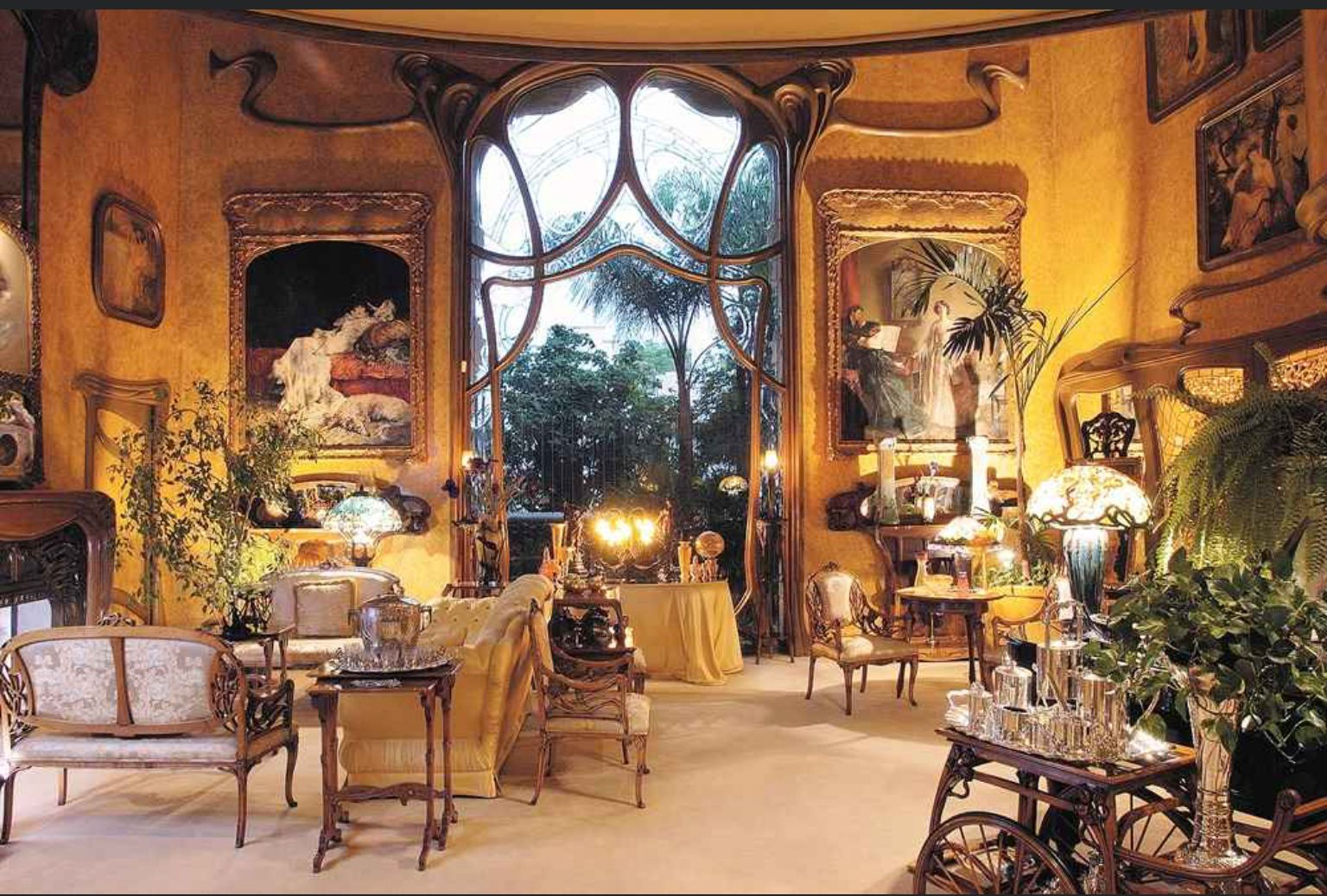Art Nouveau Design
Designing a room in the Art Nouveau style involves embracing the movement’s core principles: natural forms, flowing lines, and intricate details. Art Nouveau, popular from the late 19th century to the early 20th century, sought to break down the barriers between fine arts and applied arts, creating beautiful, harmonious environments. Here’s how you can infuse your space with the elegance and organic motifs characteristic of Art Nouveau:
1. Incorporate Nature-Inspired Elements
- Use patterns and decorations that mimic the natural world. Look for wallpaper, textiles, and decorative items featuring flowers, leaves, vines, and other botanical motifs, as well as birds and insects.
- Choose furnishings with curvilinear forms and organic shapes. Furniture pieces often have flowing lines and are made from materials like wrought iron and wood, with decorative inlays.
2. Emphasize Curved Lines
- Art Nouveau is known for its “whiplash” curves and sinuous forms. Include furniture and decor that exhibit these smooth, flowing lines.
- Architectural elements like arched doorways, stained glass windows, and decorative moldings can reinforce the style.
3. Select a Harmonious Color Palette
- Opt for a color scheme that reflects the natural inspiration of Art Nouveau. Use muted earth tones like greens, browns, and blues, accented with brighter hues of peacock blue, mustard yellow, and lilac.
- Incorporate these colors through paint, wallpapers, and textiles to create a cohesive and immersive environment.
4. Use Decorative Lighting
- Lighting is a key component of Art Nouveau interiors. Tiffany lamps, with their stained glass shades featuring nature-inspired designs, are quintessentially Art Nouveau.
- Look for lighting fixtures with organic shapes and materials that echo the overall design theme.
5. Add Artistic and Decorative Accents
- Embellish the room with decorative objects that showcase the intricate craftsmanship and aesthetic of the period. This can include vases, clocks, and statuettes with natural motifs.
- Hang Art Nouveau prints or posters, especially works by Alphonse Mucha or Gustav Klimt, to reinforce the artistic connections.
6. Focus on Craftsmanship and Materials
- Choose high-quality materials that were popular during the Art Nouveau period, such as stained glass, wrought iron, and polished wood. The emphasis should be on craftsmanship and detail.
- Incorporate textiles and upholstery with embroidered or woven patterns reflecting natural themes.
7. Architectural Features and Finishing Touches
- If possible, integrate architectural elements like mosaic tile floors, ornate columns, and sculptural reliefs into your design.
- Use mirrors with ornate, organic frames to add depth and light to the room, further enhancing the Art Nouveau aesthetic.
8. Be Mindful of Space and Layout
- Arrange your space to create a flow that feels natural and uncluttered. Art Nouveau spaces should feel harmonious and integrated, with each element contributing to the overall aesthetic.
Designing an Art Nouveau room requires a careful balance between embracing the style’s distinctive features and adapting them to modern living needs. By focusing on natural motifs, flowing lines, and harmonious colors and materials, you can create a space that feels both timeless and intimately connected to the natural world.
Art Nouveau color schemes draw heavily from the natural world, featuring a sophisticated palette that combines muted earth tones with vibrant jewel tones. The goal is to create a harmonious, organic feel that reflects the style’s inspiration from nature and the emphasis on elegant, flowing designs. Here’s a closer look at the colors typical of Art Nouveau interiors and how they are used:
Earth Tones
- Greens: Ranging from olive to sage, green is a staple in Art Nouveau designs, symbolizing the movement’s connection to nature. It’s often used as a base color for walls or textiles.
- Browns and Beiges: These colors provide a neutral backdrop that complements more vibrant accents. Wood, a prominent material in Art Nouveau furniture and decorations, naturally brings these hues into the space.
- Deep Blues: Reminiscent of both the sky and the sea, deep blues add depth and serenity to the palette.
Jewel Tones
- Peacock Blue: This bright, rich blue-green shade is iconic in Art Nouveau design, adding a splash of color that mimics the vibrancy of natural peacock feathers.
- Mustard Yellow: A warm, earthy yellow can brighten the space and works well with both the muted and more vibrant elements of the palette.
- Lilac and Lavender: Soft purples inspired by flowers, these hues add a gentle touch of color that is both romantic and natural.
Metallics
- Gold and Copper Accents: Metallics are used sparingly to add a touch of luxury and reflectivity. They are often found in decorative elements like mirror frames, lamp bases, and architectural details.
How to Use These Colors
- Layering: Start with a neutral base of beiges or soft greens on the walls. Add furniture in rich wood tones to bring warmth and depth.
- Accents: Use jewel tones for accents. This can be through decorative pillows, art, stained glass, or even a statement piece of furniture.
- Balance: Keep the space balanced by distributing colors evenly and considering how they interact with natural light. Too many dark colors can make a room feel smaller, while too many bright colors can feel overwhelming.
- Textures: Incorporate different textures to add interest and depth. For example, a velvet throw in peacock blue can add a luxurious feel, while a silk lampshade in lilac can provide a subtle sheen.
- Nature Motifs: Use patterns and motifs from nature to bring the color scheme together. Floral wallpapers, botanical prints, or even real plants can tie the room’s elements together seamlessly.
By carefully selecting and combining these colors, you can create an Art Nouveau interior that feels both cohesive and inspired, perfectly capturing the essence of this artistic movement. Remember, the goal is to evoke the beauty of the natural world through color, form, and detail.


